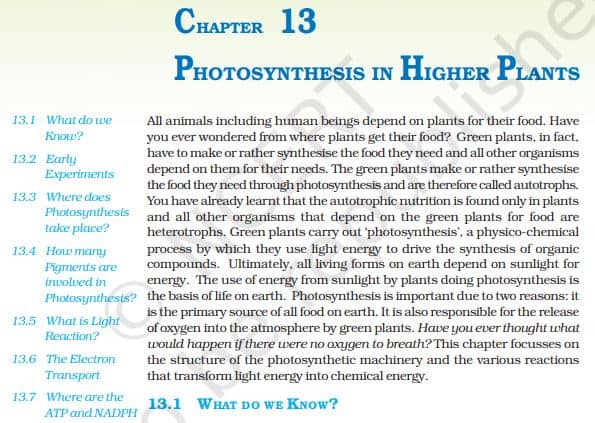‘Photosynthesis Ncert’ PDF Quick download link is given at the bottom of this article. You can see the PDF demo, size of the PDF, page numbers, and direct download Free PDF of ‘Photosynthesis In Higher Plants’ using the download button.
Photosynthesis In Higher Plants Textbook PDF Free Download

Photosynthesis Process In Higher Plants
All animals including human beings depend on plants for their food. Have you ever wondered where plants get their food?
Green plants, in fact, have to make or rather synthesize the food they need and all other organisms depend on them for their needs. The green plants make or rather synthesize the food they need through photosynthesis and are therefore called autotrophs.
You have already learned that autotrophic nutrition is found only in plants and all other organisms that depend on the green plants for food are heterotrophs.
Green plants carry out ‘photosynthesis’, a Physico-chemical process by which they use light energy to drive the synthesis of organic compounds.
Ultimately, all living forms on earth depend on sunlight for energy. The use of energy from sunlight by plants doing photosynthesis is the basis of life on earth.
Photosynthesis is important due to two reasons: it is the primary source of all food on earth. It is also responsible for the release of oxygen into the atmosphere by green plants.
Have you ever thought about what would happen if there were no oxygen to breathe? This chapter focuses on the structure of the photosynthetic machinery and the various reactions that transform light energy into chemical energy.
WHERE DOES PHOTOSYNTHESIS TAKE PLACE?
You would of course answer: in ‘the green leaf or in the chloroplasts’, based on what you earlier read in Chapter 8. You are definitely right.
Photosynthesis does take place in the green leaves of plants but it does so also in other green parts of the plants. Can you name some other parts where you think photosynthesis may occur?
You would recollect from the previous unit that the mesophyll cells in the leaves, have a large number of chloroplasts.
Usually, the chloroplasts align themselves along the walls of the mesophyll cells, such that they get the optimum quantity of incident light.
When do you think the chloroplasts will be aligned with their flat surfaces parallel to the walls? When would they be perpendicular to the incident light?
You have studied the structure of chloroplast in Chapter 8.
Within the chloroplast, there is a membranous system consisting of grana, the stroma lamellae, and the matrix stroma. There is a clear division of labor within the chloroplast.
The membrane system is responsible for trapping the light energy and also for the synthesis of ATP and NADPH. In the stroma, enzymatic reactions synthesize sugar, which in turn forms starch.
The former set of reactions, since they are directly light driven are called light reactions (photochemical reactions).
The latter are not directly light-driven but are dependent on the products of light reactions (ATP and NADPH).
Hence, to distinguish the latter they are called, by convention, dark reactions (carbon reactions).
However, this should not be construed to mean that they occur in darkness or that they are not light-dependent.
How Man Tyes Of Pigments Are Involved In Photosynthesis?
Looking at plants have you ever wondered why and how there are so many shades of green in their leaves – even in the same plant?
We can look for an answer to this question by trying to separate the leaf pigments of any green plant through paper chromatography.
Chromatographic separation of the leaf pigments shows that the color that we see in leaves is not due to a single pigment but due to four pigments: Chlorophyll a (bright or blue-green in the chromatogram).
chlorophyll b (yellow-green), xanthophylls (yellow), and carotenoids (yellow to yellow-orange).
Let us now see what roles various pigments play in photosynthesis.
Pigments are substances that have the ability to absorb light, at specific wavelengths. Can you guess which is the most abundant plant pigment in the world?
Let us study the graph showing the ability of chlorophyll a pigment to absorb lights of different wavelengths.
Of course, you are familiar with the wavelength of the visible spectrum of light as well as the VIBGYOR.
WHAT IS A LIGHT REACTION?
Light reactions or the ‘Photochemical’ phase include light absorption, water splitting, oxygen release, and the formation of high-energy chemical intermediates, ATP and NADPH. Several protein complexes are involved in the process.
The pigments are organized into two discrete photochemical light-harvesting complexes (LHC) within Photosystem I (PS I) and Photosystem II (PS II).
These are named in the sequence of their discovery, and not in the sequence in which they function during the light reaction.
The LHC is made up of hundreds of pigment molecules bound to proteins.
Each photosystem has all the pigments (except one molecule of chlorophyll a) forming a light-harvesting system also called antennae (Figure 13.4).
These pigments help to make photosynthesis more efficient by absorbing different wavelengths of light.
| Author | NCERT |
| Language | English |
| No. of Pages | 20 |
| PDF Size | 2.5 MB |
| Category | Education |
Related PDFs
Carbon And Its Compounds Class 10 PDF
Work Power And Energy Class 9 NCERT PDF
Photosynthesis In Higher Plants PDF Free Download
